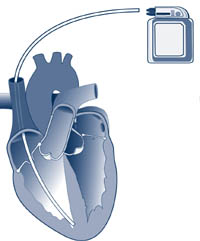How is an arrhythmia treated ?
Treatment depends on the type and severity of your arrhythmia. In some cases, no treatment is necessary. Treatment options include medications, lifestyle changes, invasive therapies, electrical devices or surgery.
Medications
Antiarrhythmic drugs are medications used to convert the arrhythmia to a normal sinus rhythm or to prevent an arrhythmia. Other medications may include heart rate-control drugs and anticoagulant or antiplatelet drugs such as warfarin (a “blood thinner”) or aspirin, which reduce your risk of stroke or developing blood clots.It is important that you know the names of your medications, why they are prescribed, how often and at what times to take them, what side effects may occur, and what medications you have previously taken for your arrhythmia.
Lifestyle changes
Airrhythmias may be related to certain lifestyle factors. The following tips can help limit the occurrence of arrhythmias:
- If you smoke, stop.
- Limit your intake of alcohol.
- Limit or stop using caffeine. Some people are sensitive to caffeine and may notice more symptoms when using caffeinated products, such as tea, coffee, colas and some over-the- counter medications.
- Avoid using stimulants. Beware of stimulants used in cough and cold medications and herbal or nutritional supplements. Some of these substances contain ingredients that cause irregular heart rhythms. Read the label and ask your doctor or pharmacist which medication is best for you.
- Your family may also want to be involved in your care by learning to recognize your symptoms and how to start CPR if needed.
- If you notice that your irregular heart rhythm occurs more often with certain activities, you should avoid them.
Invasive therapies
Electrical cardioversion and catheter ablation are invasive therapies used to treat or eliminate irregular heart rhythms. Your doctor will determine the best treatment for you and discuss the benefits and risks of these therapies with you.
- Electrical cardioversion Patients with persistent arrhythmias, such as atrial fibrillation, may not be able to achieve a normal heart rhythm with drug therapy alone. Electrical cardioversion delivers an electrical shock to your chest wall, which synchronizes the heart and allows the normal rhythm to restart. This procedure is done after you receive short-acting anesthesia.
-
Catheter ablation : During ablation, energy is delivered through a catheter to tiny areas of the heart muscle. This energy can either “disconnect” the pathway of the abnormal rhythm, block the abnormal pulses and promote normal conduction of impulses, or disconnect the electrical pathway between the atria and the ventricles.
- Pulmonary vein isolation: In patients with frequent, paroxysmal or persistent atrial fibrillation, isolation of the pulmonary veins is a procedure that uses special catheters to render bands of vein tissue, thought to cause atrial fibrillation, dysfunctional. The goal is to isolate, rather than ablate, the foci responsible for triggering atrial fibrillation through a circumferential conduction block.
- Electrical devices
- Permanent pacemaker : A device that sends small electrical impulses to the heart muscle to maintain a normal heart rate. The pacemaker has a pulse generator (which houses a battery and a tiny computer) and leads (wires) that send impulses from the pulse generator to your heart muscle, as well as sense the heart’s electrical activity. Pacemakers are mostly used to prevent the heart from beating too slowly. Newer pacemakers have many sophisticated features that are designed to help manage arrhythmias, optimize heart rate-related functions and improve synchronization.
- Implantable cardioverter-defibrillator (ICD) : A sophisticated electronic device used primarily to treat ventricular tachycardia and ventricular fibrillation — two life-threatening abnormal heart rhythms. The ICD constantly monitors the heart rhythm. When it detects a very fast, abnormal heart rhythm, it delivers energy to the heart muscle to cause the heart to beat in a normal rhythm again.
There are several ways an ICD can restore a normal heart rhythm:
- Antitachycardia pacing (ATP): When the heart beats too fast, a series of small electrical impulses are delivered to the heart muscle to restore a normal heart rate and rhythm.
- Cardioversion: A low-energy shock is delivered at the same time as the heartbeat to restore a normal heart rhythm.
- Defibrillation: When the heart is beating dangerously fast or irregularly, a higher energy shock is delivered to the heart muscle to restore a normal rhythm.
- Antibrachycardia pacing: Many ICDs provide back-up pacing to prevent heart rhythms that are too slow.
Heart surgery
Surgery may be needed to correct arrhythmias that can’t be controlled with medications or nonsurgical treatment methods. Arrhythmia surgery may also be recommended if you need surgery, such as valve surgery or bypass surgery, to correct other forms of heart disease. The Maze and modified Maze procedures are two surgeries used to correct atrial fibrillation.Your doctor will determine the best treatment for you and discuss these options with you, including more information about surgical treatment if it is an appropriate treatment option.
